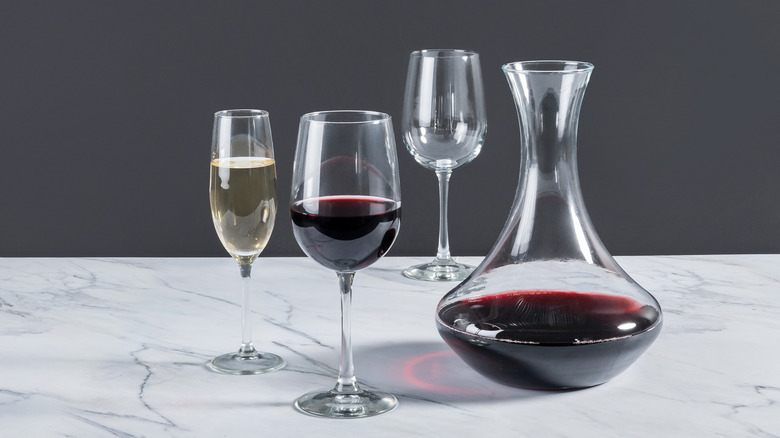The Biggest Wine Decanting Mistake Is Easy To Avoid
It's time to upgrade your wine tasting experience and learn how to expertly decant your bottle of wine. Good news: the process is rather straightforward when it gets down to it (just beware of those people trying to talk you into hyper-decanting). That is, so long as you have the proper tools, avoid common mistakes, and start your process early enough. Maximilian Riedel, CEO and President of Riedel, an esteemed wine glass company that has been manufacturing thoughtfully designed, quality wine glasses since 1756, shares his insight on how to best decant wine. It starts by steering clear of a few preventable oversights.
"The biggest mistakes people make when it comes to wine decanting is not decanting at all," says Riedel. "I often recommend to those who are new to wine to first invest in entry-level decanters that are made to be versatile, such as the Riedel Veloce Decanter. This decanter is approachably priced, easy to use, and can be used as a craft for other beverages, making it a great entry level decanter."
How to properly use a wine decanter
Decanting the flavor and aroma of wine through aeration, which works by exposing the wine to air, motivating certain flavors to "wake up" after spending so much time in a bottle. Aeration allows complex notes to be more present and — when done properly — for liquid to separate from sediment within the bottle, making the wine tasting experience even smoother.
To decant your wine, place your bottle with the cork (or screw top, which is arguably superior) upwards. Leave your bottle for approximately 24 hours to let sediment fall to the bottom of the glass. After a day has passed, pour the liquid into the decanter slowly, ensuring that the bottom of the bottle stays relatively low so sediment doesn't also slip out. To successfully decant, it's crucial to leave a bit of wine in the bottle for this reason. Remember, it is perfectly safe to drink the sediment; wine decanting serves as a method to augment the wine's aroma, not as a safety precaution.
Riedel shares a final piece of insight regarding wine decanting technique: "Each decanter is unique, so you must also follow the directions provided by the creator of the glassware to ensure you are using it properly." And once you're done, clean your decanter by soaking then rinsing it with lukewarm water and a little vinegar, before letting it completely dry. While you're learning about wine, learn how to properly store your red wine after opening.

